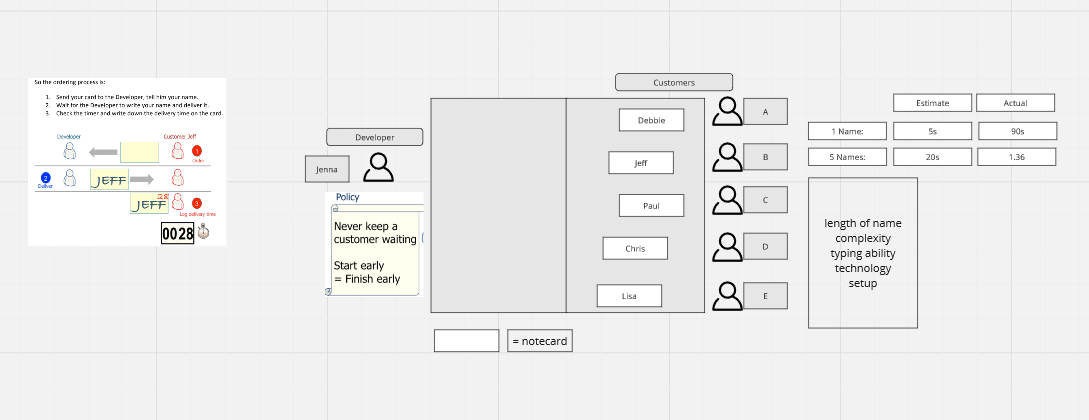
October 12th’s AGTC meetup featured Marissa Fogal facilitating The Multitasking Name Game.
Henrik Kniberg, an Agile coach (currently at Crisp), does a fantastic job with creating visualizations and simulations to help teams discover and experience potential pain points in their systems. In 2011, Henrik developed “The Multitasking Name Game”, a hands-on experience to help teams understand the positive impacts of managing WIP limits and the negative effects of multi-tasking. Marissa virtualized the activity by leveraging a Miro board.
The Facilitation Guide (linked below) provides details on setup, game play, and debriefing questions. It’s suggested that when you facilitate this activity, leave off the name of the activity. Not mentioning multi-tasking right away will provide an opportunity for the team to experience an “a-ha!” moment and come to conclusions on their own.
We started by guessing how long it would take to write a name on a notecard and then we guessed how long it might take to write 5 names on 5 notecards. We asked for 1 volunteer to act as the ‘developer’ and 5 volunteers to act as ‘customers’. And then we jumped into game play. The intent of the game is to capture names on notecards. Sounds simple, but what are some obstacles that could get in the way or slow things down?
For the first round, customers were asked to push all their notecards to the developer. The developer typed the first letter of customer A on their notecard, then the first letter of customer B on their notecard, then the first letter of customer C on their notecard, and so on. Once each customer had the first letter of their names on their notecards, the developer moved to writing the second letter of each name on their notecards. This continued until the developer completed typing a name on a notecard. Once a full name was typed, the developer would push the notecard to the customer, and they would accept (or reject) the notecard. The developer continued to populate the rest of the notecards and hand them to customers. During this typing activity, a person captured the start time and end time for each customer and the total time for typing all 5 names. We discovered that the developer averaged 90 seconds for one name and 1 minute and 36 seconds for all 5 names. Wow! Much longer than our original guesses.
For the second round, we switched companies; our new company supports WIP limits (of 1) and the developer was able to pull notecards to work on, instead of having them pushed over. Like the first round, we wanted the developer to type names on notecards, except this time, the developer could populate the entire notecard with the customer’s full name (instead of populating letter by letter). The developer would grab a notecard, type the customer’s name, pass it back to the customer, and then move on to the next customer. Again, a person timed the activity by capturing the start and end time for each customer and then total time for typing all 5 names. This time, the first name was completed in 5 seconds and all 5 names were completed in 35 seconds. We were much closer to original guess than the first round.
We then moved into a debriefing session, where we compared the two rounds, talked about how things went from the developer perspective, how things went from the customer perspective, what did we observe, etc. Customers enjoyed the transparency in the second round. They had a better sense of when their item would be started as they could see the progress being made. It felt less stressful for the developer to focus on one item at a time.
One component we lacked – Henrik includes an awesome chart that helps visualize the 2 rounds (image in the linked PDF). Materials were ready to capture the information, but it would have taken a couple minutes to populate the data. Suggestions might be to have another person capture (and chart) the information while game play is happening or discover a way to populate the data in real time.
Connect with Marissa: LinkedIn
Game Links: Facilitator’s Guide